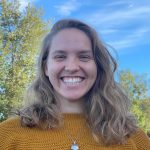
Hello from the new voice here in the Community Corner! Since joining the staff in early August, I have enjoyed launching into and paddling around the vast and deep waters of the Council’s work. I step into the outreach coordinator role with my background as a naturalist, science and environmental educator, dancer, and outreach program manager.
I know the joy of facilitating young people learning about the nature that surrounds them. There is a specific excitement that comes when you help someone make a new connection about a science-based fact. I recognize the importance of clear information leading to an audience’s inspiration, which leads them to action.
As I explore and learn about the Council, I am sparked by the variety of community outreach accomplished and funded throughout the region. The Youth Involvement project stands out. As in years previous, the Council provided funding for educating the youth in our community on topics related to the Council’s mission, such as citizens’ oversight, environmental impacts of the operation of the Alyeska Pipeline Service Company oil terminal in Valdez and the oil tankers that call there, oil spill prevention, and response planning and operation. Eight programs were funded this year.
The Council sponsored a new youth track at the Prince William Sound Natural History Symposium this year, put on by the Prince William Sound Stewardship Foundation to encourage and engage young people in the Prince William Sound region. These presentations and others from the symposium are available online at the foundation’s website: Prince William Sound Stewardship Foundation – 2022 Symposium
Oil spill prevention and response engineering was taught through the remotely operated vehicles, or ROV challenge at this year’s Tsunami Bowl. This challenge was put on by the Prince William Sound Science Center. Youth Involvement also funded writing a ROV Kit Build-Guide for other educators to teach robotics and Exxon Valdez oil spill history and aftermath. It is available on their website. PWSSC’s R.O.V. Kit Build-Guide: How to build a simple remotely operated vehicle for classroom use
Among the rest are oil spill education for students via the Center for Alaskan Coastal Studies and the Copper River Watershed Project, and for teachers during Alaska Geographic’s Kenai Fjords Floating Teacher Workshop and Prince William Sound College’s Ecology for Teachers course.
The Youth Involvement projects are indicative of the many modes of community outreach that are important to share the Council’s mission and the varied work of the staff and committees. Each connection the community of volunteers, staff, and partners make with the Council’s audiences – be it the member communities and groups, the greater scientific community, oil industry and regulators, or the citizens of the region affected by the Exxon Valdez oil spill – is a paddle dipping into the water and pushing the Council’s metaphorical kayak forward.
I look forward to continuing to tell the story of the spill, foster the network of organizations doing oil spill prevention and response education, and to inviting learners of all ages to understand their environment. As always, our goal remains to continue the Council’s mission through engaging our community members in meaningful experiences and inspiring new and long-time environmental stewards.